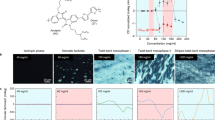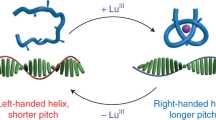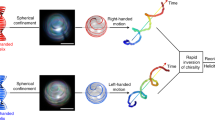Abstract
From seashells to DNA, chirality is expressed at every level of biological structures. In self-assembled structures it may emerge cooperatively from chirality at the molecular scale. Amphiphilic molecules, for example, can form a variety of aggregates and mesophases that express the chirality of their constituent molecules at a supramolecular scale of micrometres (refs 1–3). Quantitative prediction of the large-scale chirality based on that at themolecular scale remains a largely unsolved problem. Furthermore, experimental control over the expression of chirality at the supramolecular level is difficult to achieve4,5,6,7: mixing of different enantiomers usually results in phase separation18. Here we present an experimental and theoretical description of a system in which chirality can be varied continuously and controllably (‘tuned’) in micrometre-scale structures. We observe the formation of twisted ribbons consisting of bilayers of gemini surfactants (two surfactant molecules covalently linked at their charged head groups). We find that the degree of twist and the pitch of the ribbons can be tuned by the introduction of opposite-handed chiral counterions in various proportions. This degree of control might be of practical value; for example, in the use of thehelical structures as templates for helical crystallization of macromolecules8,9.
This is a preview of subscription content, access via your institution
Access options
Subscribe to this journal
Receive 51 print issues and online access
$199.00 per year
only $3.90 per issue
Buy this article
- Purchase on Springer Link
- Instant access to full article PDF
Prices may be subject to local taxes which are calculated during checkout




Similar content being viewed by others
References
Schnur, J. M. Lipid tubules: a paradigm for molecularly engineered structures. Science 262, 1669–1676 (1993).
Fuhrhop, J.-H. & Helfrich, W. Fluid and solid fibers made of lipid molecular bilayers. Chem. Rev. 93, 1565–1582 (1993).
Rowan, A. E. & Nolte, R. J. M. Helical molecular programming. Angew. Chem. Int. Edn 37, 63–68 (1998).
Chung, D. S., Benedek, G. B., Konikoff, F. M. & Donovan, J. M. Elastic free energy of anisotropic helical ribbons as metastable intermediates in the crystallization of cholesterol. Proc. Natl Acad. Sci. USA 90, 11341–11345 (1993).
Spector, M. S. et al. Controlling the morphology of chiral lipid tubules. Langmuir 14, 3493–3500 (1998).
Prins, L. J., Huskens, J., de Jong, F., Timmerman, P. & Reinhoudt, D. N. Complete asymmetric induction of supramolecular chirality in a hydrogen-bonded assembly. Nature 398, 498–502 (1999).
Yashima, E., Maeda, K. & Okamoto, Y. Memory of macromolecular helicity assisted by interaction with achiral small molecules. Nature 399, 449–451 (1999).
Ringler, P., Muller, W., Ringsdorf, H. & Brisson, A. Functionalized lipid tubules as tools for helical crystallization of proteins. Chem. Eur. J. 3, 620–625 (1997).
Wilson-Kubalek, E. M., Brown, R. E., Celia, H. & Milligan, R. A. Lipid nanotubes as substrates for helical crystallization of macromolecules. Proc. Natl Acad. Sci. USA 95, 8040–8045 (1998).
Zana, R. & Talmon, Y. Dependence of aggregate morphology on structure of dimeric surfactants. Nature 362, 228–230 (1993).
Oda, R., Huc, I. & Candau, S. J. Gemini surfactants as new, low molecular weight gelators of organic solvents and water. Angew. Chem. Int. Edn 37, 2689–2691 (1998).
Oda, R. et al. Elongated aggregates formed by cationic gemini surfactants. Langmuir 15, 2384–2390 (1999).
de Gennes, P. G. & Prost, J. The Physics of Liquid Crystals2nd edn (Clarendon, Oxford, (1993).
Helfrich, W. Elastic properties of lipid bilayers: theory and possible experiments. Z. Naturforsch. C 28, 693–703 (1973).
Helfrich, W. & Prost, J. Intrinsic bending force in anisotropic membranes made of chiral molecules. Phys. Rev. A 38, 3065–3068 (1988).
Selinger, J. V., MacKintosh, F. C. & Schnur, J. M. Theory of cylindrical tubules and helical ribbons of chiral lipid membranes. Phys. Rev. E 53, 3804–3818 (1996).
Thomas, B. N., Safinya, C. R., Plano, R. J. & Clark, N. A. Lipid tubule self-assembly: length dependence on cooling rate through a first-order phase transition. Science 267, 1635–1638 (1995).
Singh, A. et al. Lateral phase separation based on chirality in a polymerizable lipid and its influence on formation of tubular microstructures. Chem. Phys. Lipids 47, 135–148 (1988).
Acknowledgements
This work was supported by the CNRS, INSERM, l'Hôpital Universitaire de Strasbourg, and Rhône-Poulenc. F.C.M. was supported in part by the CNRS, the Deutsche Forschungsgemeinschaft, the National Science Foundation, and the Petroleum Research Fund (administered by the ACS).
Author information
Authors and Affiliations
Corresponding author
Rights and permissions
About this article
Cite this article
Oda, R., Huc, I., Schmutz, M. et al. Tuning bilayer twist using chiral counterions. Nature 399, 566–569 (1999). https://doi.org/10.1038/21154
Received:
Accepted:
Issue Date:
DOI: https://doi.org/10.1038/21154
This article is cited by
-
Frustrated self-assembly of non-Euclidean crystals of nanoparticles
Nature Communications (2021)
-
Astral hydrogels mimic tissue mechanics by aster-aster interpenetration
Nature Communications (2021)
-
Shape and fluctuations of frustrated self-assembled nano ribbons
Nature Communications (2019)
-
Synthetic asters as elastic and radial skeletons
Nature Communications (2019)
-
Molecular engineering of chiral colloidal liquid crystals using DNA origami
Nature Materials (2017)
Comments
By submitting a comment you agree to abide by our Terms and Community Guidelines. If you find something abusive or that does not comply with our terms or guidelines please flag it as inappropriate.



